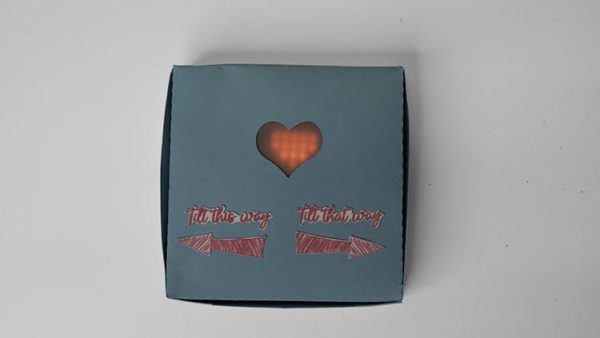Motion
micro:bit project: Interactive Valentine
Description
This project shows you how to create an interactive box that uses movement as an input to determine the behavior of a micro:bit. The box is designed to be big enough to hold a micro:bit and a battery pack. There is a heart-shaped cutout to display the LED array embedded on the front of the micro:bit. The micro:bit is coded to play a song and to display a flashing heart based on the box being tilted right or left. The pattern box for the project was cut using a Silhouette Cameo 4 but it is simple enough to cut by hand.
Programming Language
Difficulty Level
Beginner
Age Range
11 and up.
Materials
- micro:bit V2
- Battery pack
- Box with room for a micro:bit and battery pack. Here are the patterns for the box and cutouts I used
- Vellum
- double-sided sticky tape to secure vellum
- 3d adhesive squares to secure micro:bit and battery pack
- glue, sticky dots, or other adhesives to build the box
Note: If you are using a version 1 micro:bit, you will need to add a speaker. My recommendation is the Pimoroni noise:bit.
Designing the Project
Develop the problem statement
This project is about creating a fun way to incorporate a micro:bit into a paper crafting project. An important feature is to make it easy for the user to interact with the micro:bit. The micro:bit has two built-in ways of communicating: lights and sound. I want to have the project use both of these.
The problem statement I used for this project was:
Create something that can hold a micro:bit and battery pack, Have two inputs that the user can initiate with no training, Have the micro:bit react to one input by playing a melody and to the other input with an animated light display.
- Create a box big enough to hold the micro:bit.
- Use tilt right and tilt left as the inputs since having the micro:bit hidden in a box rules out using the buttons and the touch pads as input.
Write the Algorithm
When box is tilted left, play a song
When box is pointed right, draw a heart and flash it 3 times
Write the Pseudocode
This project is set up to sense two behaviors from the micro:bit and respond differently depending on the behavior. The code is going to have two event blocks and initialize anything else in the ‘on start’ block:
- When ‘on start’
- Initialize speaker (V2 micro:bit only)
- When ’tilt left’
- Play first several notes of “Can’t Help Falling in Love”, sung by Elvis Presley
- When ’tilt right’
- Repeat 3 times Draw a heart in three steps
- for 3 times
- flash it off and on
Write and Test the Code
Here is the Sample code that I wrote.
Build the box

